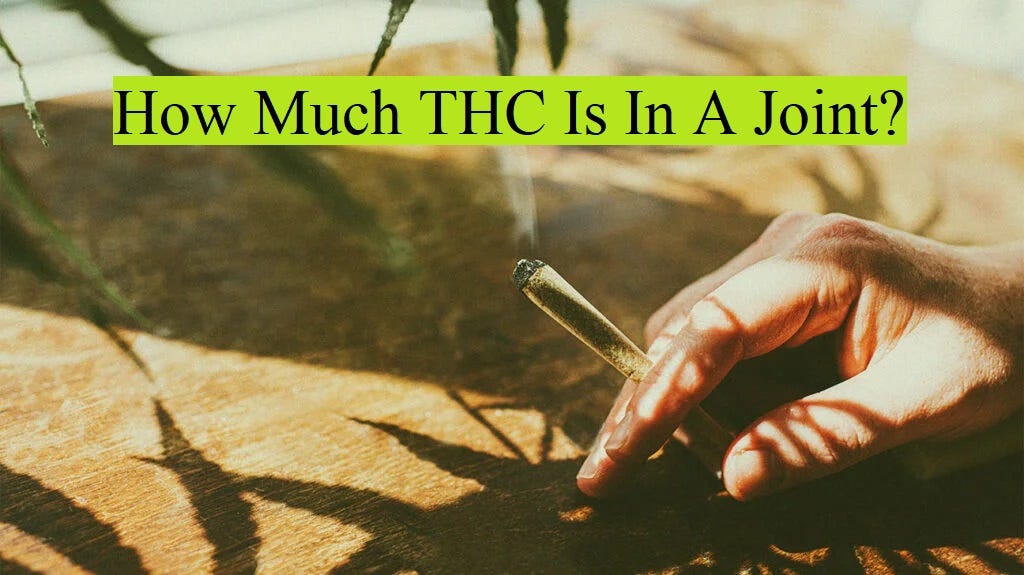How Much THC Is in a Joint and How Much Is Absorbed When Smoking?
Two of the most common questions around smoking cannabis are: How much do I need to smoke to get high? How much THC is in a joint? Read on for the answers.
A common question among cannabis enthusiasts is: how much THC is in a joint, and how much of it do you actually consume? Understanding the amount of THC delivered to your body involves analyzing several factors, including joint size, the THC/THCA content of the flower, the effects of combustion, and bioavailability.
While each individual’s experience with cannabis varies depending on personal factors like tolerance, metabolism, and lung capacity, this article explores the variables influencing THC absorption. We’ll also compare the efficiency of joints with other methods like vaping and smoking from a bong or bowl.
How Much Weed Is in a Typical Joint?
The size of a joint plays a crucial role in determining how much THC it contains. Commonly, pre-rolls and self-rolled joints fall into these categories:
0.3 grams: Research from a 2016 study found that the average joint weighs approximately 0.3 grams, based on federal drug arrest data.
0.5 grams: Half-gram pre-rolls are a popular choice in dispensaries.
1 gram: Larger one-gram joints are also available and often shared among multiple users.
For this discussion, we’ll use the 0.3-gram joint as a baseline. However, the actual amount of cannabis in a joint may vary depending on personal preferences and local norms.
Calculating the THC in a Joint
In raw cannabis, THC exists mainly as tetrahydrocannabinolic acid (THCA), which converts to THC when heated through a process called decarboxylation. Calculating the potential THC content involves the following steps:
Determine the THC percentage: Most strains have a THC content ranging from 15% to 25%, with some high-potency strains reaching up to 30%.
Multiply by the weight of the joint: Convert the weight of the joint from grams to milligrams (e.g., 0.3 grams = 300 mg) and multiply by the THC percentage.
Example Calculation:
A 0.3-gram joint with 20% THC contains:
300 mg×0.20=60 mg of THC.
THCA to THC Conversion
Decarboxylation, triggered by heat, converts THCA into psychoactive THC. However, this conversion is not perfectly efficient. Approximately 87.7% of THCA is converted to THC due to differences in molecular weight. The following formula estimates total THC:
Total THC=THC+(THCA×0.877)
For example, if a strain contains 18% THCA and 2% THC, the total THC is:
0.02+(0.18×0.877)=0.1778 or 17.78%.0.02 + (0.18 x 0.877) = 0.1778 or 17.78%
How Much THC Is Consumed When Smoking?
Not all the THC in a joint reaches your bloodstream. This is due to losses from combustion and bioavailability limitations.
Loss Through Combustion
When cannabis burns, around 40% of the THC is lost due to the high heat, which destroys cannabinoids, and sidestream smoke that dissipates between puffs. Joints are particularly inefficient because the cherry (the burning tip) stays lit even when not being inhaled.
Smoking with a bong or pipe is more efficient because these methods burn cannabis only when directly exposed to a flame, reducing sidestream smoke. This can lower THC loss to around 30%, compared to the 40% lost with a joint. Additionally, bongs allow for larger, concentrated hits, which may improve THC delivery with each inhalation.
Bioavailability
Bioavailability refers to the proportion of THC that enters the bloodstream. For inhaled cannabis, bioavailability ranges from 10% to 35%, depending on factors like lung capacity and smoking technique.
Using a 0.3-gram joint with 60 mg of THC:
After accounting for combustion losses, 36 mg of THC remains available.
Assuming a bioavailability of 35%, only 12.6 mg of THC is absorbed into the bloodstream.
Dry Herb Vaporizers: A More Efficient Alternative
A dry herb vaporizer is one of the most efficient ways to consume cannabis. Unlike smoking, vaporizers heat cannabis to a controlled temperature (typically 315°F to 440°F) that is below the point of combustion. This preserves cannabinoids and terpenes while still decarboxylating THCA into THC.
THC Loss with Vaporizers
Using a vaporizer, less than 10% of the THC is lost, compared to the 30-40% lost during smoking. This means a vaporizer can deliver up to 90% of the THC present in the cannabis.
For example, a 0.3-gram joint with 60 mg of THC might deliver around 12.6 mg due to losses from combustion and bioavailability. In contrast, vaporizing the same amount of cannabis could deliver 30-35 mg of THC, thanks to higher efficiency and bioavailability.
Additionally, vaporizers produce smoother, less harsh vapor and preserve terpenes, leading to a more flavorful and lung-friendly experience.
Cannabis Oil Vape Carts vs. Joints
Cannabis oil vape cartridges offer another efficient alternative. These carts often contain concentrated oil with 60% to 90% THC.
Efficiency of Vaping THC Oil
THC cart vapes avoid combustion entirely, resulting in minimal THC loss. The bioavailability when vaping oil is closer to 50%, making it more efficient than smoking.
For example:
A single puff from a vape delivering 5 mg of THC could result in 2.5 mg absorbed, which is comparable to smoking a small portion of a joint.
A 0.3-gram joint with 20% THC delivers about 12.6 mg of THC, equivalent to 4-5 puffs from a vape cart.
Conclusion
The amount of THC consumed depends on factors like joint size, cannabis potency, and the method of consumption. A 0.3-gram joint with 20% THC delivers about 12.6 mg of THC to the bloodstream, although this may vary based on individual physiology.
Smoking is less efficient due to combustion losses, while methods like using bongs or vaporizers preserve more THC. Dry herb vaporizers, in particular, are highly efficient, delivering up to 90% of the THC and providing a cleaner, more flavorful experience. Similarly, cannabis oil vape carts offer high efficiency and convenience, making them an attractive option for users seeking a precise and effective THC dose.
By understanding these differences, cannabis users can make more informed decisions about their preferred consumption methods and optimize their experience.




